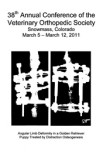OBJECTIVES: To evaluate the outcome and complications following surgical stabilization of canine tarsocrural luxations.
METHODS: Medical records of dogs which were surgically treated for tarsocrural joint instability between February 2007 and June 2014 were reviewed. Surgical technique, complications and long-term outcome (via questionnaire and Canine Brief Pain Inventory) were assessed.
RESULTS: Twenty-four dogs (26 joints) were included. All injuries were traumatic. All joints had associated fractures; malleolar in 21/26 limbs (13/26 medial). Eight joints had internal fracture fixation and transarticular external skeletal fixator, six had external fixator alone, four had prosthetic ligaments with external fixator, and four had prosthetic ligaments with external coaptation. Two joints had pantarsal arthrodesis and two primary ligament repair. Complications occurred in 24/26 limbs giving 45 distinct complications; 16 were minor, 29 major, and 31 complications were external fixator associated. Prosthetic ligaments were significantly associated with major complications (p = 0.017); five out of eight required subsequent removal between 105-1006 days. Cost was significantly associated with major complications (p = 0.017) and soft tissue wounds (p = 0.03). Long-term lameness was seen in nine of 14 dogs. There was no association between pain severity (p = 0.3) and pain interference scores (p = 0.198) when comparing stabilization methods.
CLINICAL SIGNIFICANCE: Complications are common; however many are external fixator related. Prosthetic ligaments are significantly associated with major complications. Regardless of technique, a degree of ongoing lameness is likely.
Short and long-term outcome following surgical stabilization of tarsocrural instability in dogs
Journal
Beever LJ, Kulendra ER, Meeson RL. Vet Comp Orthop Traumatol. 2016 Mar 18; 29 (2): 142-8.









